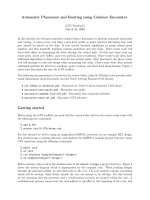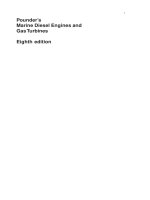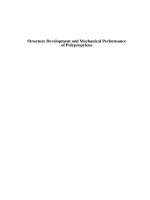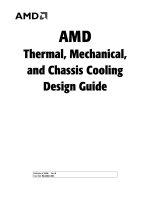Know and Understand Centrifuga I Pumps docx
Bạn đang xem bản rút gọn của tài liệu. Xem và tải ngay bản đầy đủ của tài liệu tại đây (7.75 MB, 270 trang )
Know
and
Understand
CUSTODIO
c
Know and
Understand
Cen tr
if
ug
a
I
Pumps
Know and
Understand
Cent
r
if
u
g
a
I
Pumps
by Larry Bachus and
Angel Custodio
ELSEVIER
UK
USA
JAPAN
Elsevier
Ltd,
The Boulevard, Langford Lane, Cdlington, Oxford
OX5 lGB, UK
Elsevier Inc, 360
Park
Avenue South, New York,
NY
1001
0-
171
0,
USA
Elsevier Japan, Tsunashima Building Annex,
3-20-
12 Yushima,
Bunkyo-ku, Tokyo
11
3,
Japan
Copyright
0
2003
Bachus Company, Inc.
Published by Elsevier Ltd
All
rights reserved.
All rights reserved.
No
part of this publication may be reproduced, stored in
a
retrieval system
or
transmitted in any form or by any means: electronic,
electrostatic, magnetic tape, mechanical, photocopying, recording
or
otherwise,
without permission in writing from the publishers.
British Library Cataloguing in Publication Data
Bachus, Larry
Know and understand centrifugal pumps
1
.Centrifugal pumps
I.Title II.Custodio, Angel
62
1.6’7
ISBN 1856174093
No responsibility is assumed by the Publisher
for
any injury and/or damage
to
persons or property
as
a
matter
of
products liability, negligence or otherwise,
or
from any use or operation of any methods, products, instructions or ideas
contained in the material herein.
Published by
Elsevier Advanced Technology,
The Boulevard, Langford Lane, Kidlington, Oxford OX5 lGB,
UK
Tel: +44(0) 1865 843000
Fax:
+44(0)
1865
843971
Typeset by Land
&
Unwin (Data Sciences)
Ltd,
Bugbrooke
Printed and bound in Great Britain by Biddles Ltd, Guildford and King’s
Lynn
Contents
Prologue
About
the
Authors
1
Basic Pump Principles
Introduction
How
do pumps work?
Pressure measurement
Atmospheric pressure (ATM)
Absolute pressure (psia)
Gauge pressure (psig)
Vacuum
Pump head
Specific gravity
Pressure measurement
Pressures inside
the
pump
2
NPSH,
Net
Positive Suction Head
Introduction
Definition of NPSHr (required)
Definition NPSHa (available)
3
Cavitation
Introduction
Vapor pressure
Cavitation
The effects of vapor pressure on pump performance
Cavitation: A practical discussion
Review for preventing cavitation
xi
xlll
1
1
1
4
4
4
5
5
5
6
6
7
12
12
13
14
24
24
24
25
25
26
35
Contents
Cavitation review
Do
something about cavitation!
4
The
Affinity
Laws
Introduction
The Laws
The Affinity Laws and the impeller diameter
What’s the practical application of
these
laws?
5
Useful
Work
and
Pump
Efficiency
Useful work from a pump
Flow determination
Pump efficiency
Factors that affect the efficiency
Calculating pump efficiency
6
Pump
Classification
Introduction
Positive displacement pumps
Centrifugal pumps
Conceptual difference
Centrifugal volute pumps
Types of centrifugal pumps
Overhung impeller
Impeller between the bearings
Turbine pumps
Specific duty pumps
The typical
ANSI
pump
API (American Petroleum Institute) pumps
Vertical turbine pumps
Non-metallic pumps
Magnetic drive pumps
Canned motor pumps
Pump impellers
Turbine impellers
Conventional impellers
Suction specific speed,
Nss
Open impellers
Semi open impeller
Totally enclosed impeller
Wear bands
Specific speed,
Ns
37
37
39
39
39
42
42
44
44
46
48
48
50
51
51
51
54
55
56
57
57
57
58
58
58
59
60
61
62
63
64
65
66
66
70
71
71
72
73
Contents
7
Understanding
Pump
Curves
Pump performance curves
History
Head versus pressure
H-Q
Pump efficiency
The energy (BHp) curve
The pump’s minimum requirements (NPSH)
Special design pumps
Family curves
8
The System Curve
The system controls the pump
The elements of the Total Dynamic Head (TDH)
Determining the
Hs
Determining the Hp
Calculating the Hf and Hv
The dynamic system
Variable elevations
The happy zone
Dynamic pressures
Variable resistances
Short term resistance changes
Long term resistance changes
Pumps in parallel and pumps in series
Pumps in parallel
Three tips
Pumps running in series
Combined parallel and series pump operation
9
Shaft Deflection
Introduction
Operation, design and maintenance
Signs
of
shaft deflection
Interpreting the evidence
The sweet zone
The dual volute pump
76
76
77
77
78
80
81
82
85
85
92
92
92
96
96
97
110
110
113
113
116
116
117
120
122
123
124
125
128
128
133
136
137
140
141
vi
i
Contents
10
Pump
and
Motor Alignment
Introduction
Types of misalignment
Alignment techniques
Equipment alignment sequence
Coupling alignment
11
Bearings
Introduction
Bearing lubrication
Bearing failure
Bearing maintenance
Bearing seals
12
Pump
Shaft Packing
History
Vegetable fibers
Reciprocating action
Packing
Rotary action
Synthetic fibers
Compression packing
The lantern ring
The packing lubricant
Stages in
the
life of packing
13
Mechanical Seals
Pump packing
History
The mechanical seal
The single, unbalanced, inside mounted mechanical seal
The single, outside-mounted, unbalanced
seal
The single, balanced, internal mechanical seal
The single, balanced, external mechanical seal
Advantages of O-rings
The balance effect
Advantages of balance
Balance explained by math
Cartridge mechanical seals
Double seals
The tandem dual seal
The back-to-back double
seal
142
142
144
145
153
153
155
155
157
159
163
167
171
171
171
172
173
173
174
175
177
178
178
180
180
182
184
185
186
186
187
187
188
189
190
192
194
195
196
n
Vlll
Contents
The face-to-face dual seal
Support systems for dual seals
The thermal convection tank
The
turbo tank
The pumping unit
14
Failure Analysis
of
Mechanical Seals
Causes of premature seal failure
O-ring (the elastomer) failure
The elastomer sticks
to
the shaft
The
springs clog and jam
The shaft frets under the shaft seal
Incorrect installation dimension
Environmental controls for difficult sealing applications
Difficult pumping applications for mechanical seals
Environmental controls
Proper pump repair alignment methods
15
Common Sense Failure Analysis
Pump maintenance files
Failure analysis on centrifugal pumps
Why is this pump in the shop?
16
Avoiding Wear in Centrifugal Pumps
Introduction
Erosion
Corrosion
Wear rings
Fluid velocity accelerates wear
Turbulence
Throttling
17
Pump Piping
Introduction
Piping design
to
drain tanks and sumps
The Submergence Laws
197
198
198
199
200
202
202
204
209
210
21
1
212
213
2 14
215
222
226
226
227
228
232
232
232
233
233
235
235
236
238
238
238
243
Index
ix
248
Prologue
Very few industrial pumps come out of service and
go
into the
maintenance shop because the volute casing or impeller split down the
middle, or because the shaft fractured into four pieces. The majority of
pumps
go
into the shop because the bearings or the mechanical seal
failed.
Most mechanics spend their time
at
work time greasing and changing
bearings, changing pump packing, and mechanical seals. The
mechanical engineers spend their time comparing the various claims of
the pump manufacturers, trying desperately
to
relate the theory learned
at the University with the reality of the industrial plant. Purchasing
agents have
to
make costly decisions with inadequate information
at
their disposal. Process engineers and operators are charged with
maintaining and increasing production.
The focus of industrial plant maintenance has always been that the
design is correct, and that the operation
of
the pumps in the system is
as
it
should be.
In
this book, you will see that in the majority of
occasions, this is not true. Most
of
us
in maintenance spend our
valuable time, just changing parts, and in the best of cases, performing
preventive maintenance, trying
to
diminish the time required
to
change
those parts.
We almost never stop
to
consider what is causing the continual failure
of this equipment. This book will help
you
to
step away from the
fireman approach,
of
putting out fires and chasing emergencies.
This book is directed toward the understanding of industrial pumps and
their systems. It won’t be
a
guide on how
to
correctly design pumps,
nor how
to
rebuild and repair pumps. There are existing books and
courses directed toward those themes. By understanding the real
reasons for pump failure, analyzing those failures, and diagnosing pump
behavior through interpretation of pressure gauges, you can achieve
Prologue
productive pump operation and contain maintenance costs. This
book
will serve as
a
guide
to
STOP
repairing industrial pumps.
About the
Authors
Larry Bachus and Angel Custodio met each other in the early
1990s
in
Puerto Rico. Larry was working on a pump and seal conversion in a
pharmaceutical chemical plant and Angel was installing a computerized
preventive maintenance system
in
the same plant. They had passed each
other in the administrative offices at the plant and one day the
maintenance engineer introduced them and suggested they work
together. They became fast friends and have worked together on
numerous projects over the years since, including this book.
Larry
Bachus
P
Larry has almost 30-years experience in maintenance
with industrial pumps. His areas of expertise include
diagnosing pump problems and seal failures. Larry is
highly regarded for his hands-on personalized
consulting. He speaks fluent English and Spanish. He
has taught pump and seal improvement courses all
over the world. His investigations into pump failure
/
have led
to
inventions, tools and devices used in the
1
chemical process industry. He is an active member of
’
American Society of Mechanical Engineers (ASME)
and writes a column called ‘The Pump Guy’ in
Energy Tech Magazine.
l
About the Authors
Angel
Custodio
Angel specializes in the installation and imple-
mentation
of
Preventive Maintenance Systems
through his consulting engineering company formed
in
1987
in Puerto Rico. His installations have given
him the opportunity
to
look into different
approaches
to
hands-on maintenance and operator
I
mechanical components, computerized inventory
control and maintenance management.
He
is also a
member
of
ASME, and the Puerto Rican College of
Engineers.
I
c
inspections. Angel conducts seminars on pumps,
Basic Pump
Principles
In
trod
uct
ion
Pumps are used
to
transfer liquids from low-pressure zones
to
high-
pressure zones:
50
LBS
60
LBS
- -
55
LBS
L
Fiqure
1-1
55
LBS
r
Without a pump in this system, the liquid would move in the opposite
direction because of the pressure differential.
Pumps are also used
to
move liquids from
a
low elevation into a higher
elevation, and
to
move liquids from
one
place
to
another. Pumps are
also used
to
accelerate liquids through pipes.
How do
pumps
work?
The
fluid arrives
at
the pump suction nozzle as
it
flows through the
Know and Understand Centrifugal Pumps
/
\
r
I
\
suction piping. The fluid must be available
to
the pump with sufficient
energy
so
that the pump can work with the fluid’s energy. The pump
cannot suck on or draw the liquid into the pump. The concept of the
fluid being available
to
the pump is discussed in detail in Chapter
2
of
this book.
Positive displacement (I’D) pumps take the fluid at the suction nozzle
and physically capture and contain the fluid in some kind of moveable
enclosure. The enclosure may be a housing with a pulsing diaphragm,
or between the teeth of rotating gears. There are many designs. The
moveable enclosure expands and generates
a
low pressure zone,
to
take
the fluid into the pump. The captured fluid is physically transported
through the pump from the suction nozzle
to
the discharge nozzle.
Inside the pump, the expanded moveable enclosure then contracts
or
the available space compresses. This generates a zone of high pressure
inside the pump, and the fluid is expelled into the discharge piping,
prepared
to
overcome the resistance or pressure in the system. The
flow
that a PD pump can generate is mostly a function of the size
of
the
pump housing, the speed of the motor or driver, and the tolerances
between the parts in relative motion. The pressure or head that a PD
pump can develop is mostly
a
function of the thickness of the casing
and the tolerances, and the strength
of
the pump components.
As
the pump performs its duty over time, and fluid passes through the
pump, erosion and abrasive action will cause
the
close tolerance parts
to
wear. These parts may be piston rings, reciprocating rod seals,
a
flexing
diaphragm, or meshed gear teeth.
As
these parts wear, the pump will
lose its efficiency and ability
to
pump. These worn parts must be
changed with a degree of frequency based on time and the abrasive and
lubricating nature of the fluid. Changing
these
parts should not be
Basic Pump Principles
-
ROTATION
Fiaure
1-3
viewed as breakdown maintenance. Nothing is broken. This periodic
servicing is actually
a
production function
to
return the pump
to
its
best or original efficiency.
Centrifugal pumps also require that the fluid be available
to
the pump’s
suction nozzle with sufficient energy. Centrifugal pumps cannot suck or
draw the liquid into the pump housing. The principal pumping unit of
a
centrifugal pump is the volute and impeller.
(See
Figure
1-3).
The impeller is attached
to
a
shaft. The shaft spins and is powered by
the motor or driver.
We
use
the term driver because
some
pumps are
attached
to
pulleys or transmissions. The fluid enters into
the
eye
of
the
impeller and is trapped between the impeller blades. The impeller
blades contain the liquid and impart speed
to
the liquid as
it
passes
from the impeller eye toward the outside diameter of the impeller. As
the fluid accelerates in velocity, a zone of low pressure is created in the
eye
of
the impeller (the Bernoulli Principle, as velocity
goes
up,
pressure
goes
down). This is another reason
the
liquid must enter into
the pump with sufficient energy.
The liquid leaves the outside diameter of the impeller at a high rate of
speed (the speed of the motor) and immediately slams into the internal
casing wall of the volute. At this point the liquid’s centrifugal velocity
comes
to
an abrupt halt and the velocity is converted into pressure (the
Bernoulli Principle in reverse). Because the motor is spinning, there is
also rotary velocity. The fluid is conducted from
the
cutwater around
the internal volute housing in an ever-increasing escape channel.
As
the
pathway increases, the rotary velocity decreases and even more energy
Know and Understand Centrifugal Pumps
and pressure is added to the liquid (again Bernoulli’s Principle). The
liquid leaves the pump
at
discharge pressure, prepared
to
overcome the
resistance in the system.
The flow from
a
centrihgal pump is mostly governed by the speed of
the driver and the height of the impeller blades. The pressure or head
that the pump can generate is mostly governed by the speed of
the
motor and the diameter of the impeller. Other factors play a lesser role
in the pump’s flow and pressure, like the number, pitch, and thickness
of the impeller blades, the internal clearances, and the presence and
condition of the wear bands.
In simple terms,
we
could say that
PD
pumps perform work
by
manipulating the available space inside the pump. Centrihgal pumps
perform work by manipulating the velocity of the fluid as
it
moves
through the pump. There is more on this in Chapter
6.
Pressure measurement
Force (F)
is equal
to
Pressure
(P)
multiplied by the
Area
(A):
F=P
xA.
F
Pressure
is equal
to
the
Force
divided by the
Area:
P
=
-
A
If we apply pressure
to
the surface of a liquid, the pressure is
transmitted uniformly in all directions across the surface and even
through the liquid
to
the walls and bottom of the vessel containing
the
liquid (Pascal’s Law). This is expressed as pounds per square inch
(lbs/in2, or psi), or kilograms per square centimeter (k/cm2).
Atmospheric pressure (ATM)
Atmospheric pressure (ATM) is the force exerted by the weight of the
atmosphere on a unit of area.
ATM
=
14.7
psia
at sea level. As
elevation rises above sea level, the atmospheric pressure is less.
__
Absolute pressure (psia)
Absolute pressure is the pressure measured from a zero pressure
reference. Absolute pressure is
14.7
psia at sea level. Compound
pressure gauges record absolute pressure.
4
Basic Pump Principles
Gauge pressure (psig)
Gauge pressure is the pressure indicated on a simple pressure gauge.
Simple pressure gauges establish an artificial zero reference at
atmospheric pressure. The formula is:
psig
=
psia
-
ATM.
~ ~~~
Vacuum
___
-
The term vacuum is used
to
express pressures less than atmospheric
pressure (sometimes represented as a negative psi on pressure gauges).
Another scale frequently used is ‘inches of mercury’. The conversion is:
14.7
psia
=
29.92”
Hg.
Another scale gaining in popularity is the
kilopascal
(Kp)
scale.
14.7
psia
=
100
Kp
Note that there are many ways to express vacuum. Simple gauges record vacuum as a
negative psig. Compound gauges record vacuum as a positive psia. The weatherman
uses inches of mercury in the daily forecast, and millibars
(1000
millibars is
atmospheric pressure) to express the low-pressure zone in the eye of a hurricane.
Boiler operators use water column inches and millimeters of mercury to express
vacuum.
Pump manufacturers express vacuum in aspirated feet of water in a vertical column
(0
psia
=
-33.9
feet
of
water). The pharmaceutical and chemical industry uses
‘Pascals’
(100,000
Pascals
=
atmospheric pressure) and the term TORR. This
conglomeration of values and conversion rates causes confusion. In order to
understand pumps, it‘s best to think of vacuum as a positive number less than
14.7
psi.
In
our experience, we’ve found that considering vacuum
in
this form aids the
understanding of net positive suction head
(NPSH),
cavitation, suction specific speed
(Nss), and the ability of pumps to suck-up (actually pumps don’t suck, but this will do
for now) fluid from below. Remember that vacuum is the absence of atmospheric
pressure, but
it
is not a negative number.
Pump head
The term ‘pump head’ represents the net work performed on the liquid
by the pump.
It
is
composed of four parts. They are: the static head
(Hs),
or
elevation; the pressure head (Hp) or the pressures
to
be
overcome; the friction head
(Hf)
and velocity head
(Hf),
which are
frictions and other resistances in the piping system. These heads are
discussed in Chapter
8.
The head formula is the following:
5
Know
and Understand Centrifugal Pumps
Where:
H
=
head
P
=
psi
d
=
density
Pressure can be converted into head with the following equation:
2.31
x
Pressure psi
sp.gr.
Head@.
=
Where:
H
=
head in feet
2.31=
conversion factor
psi
=
pressure in pounds per square inch
sp.
gr.
=
specific gravity
Head converts
to
pressure with the following formula:
Head@.
x
sp.8~
2.31
Pressure psi
=
Specific gravity
Specific gravity is the comparison of the density of
a
liquid with the
density of water. With pumps,
it
is used
to
convert head into pressure.
The specific gravity formula is:
Density Liquid
Density Water
Sp.Gz
=
The standard for water is
60°F
at sea level.
Water is designated
a
specific gravity of
1.0.
Another liquid is either
heavier (denser) or lighter than water. The volume is not important as
long as we compare equal volumes. The specific gravity affects the
pressure in relation
to
the head, and
it
affects the horsepower
consumed by the pump with respect
to
pressure and flow. We’ll study
this in depth later.
Pressure measurement
Pressure exists in our daily lives. At sea level
the
atmospheric pressure is
14.7
psia. This is the pressure exerted on us by the air we breathe. If
we
should remove all the air, then
the
pressure would be zero.
Basic Pump Principles
We’re more concerned with pressures above atmospheric pressure. For
example, a flat tire on
a
car still has
14.7
pounds of pressure inside it.
We would consider this
to
be a flat tire because the pressure outside the
tire is equal
to
the pressure inside the tire.
We
would say the tire has no
pressure because
it
would not be inflated and could not support the
weight of the car.
What is more important
to
us is
the
differential pressure inside the tire
compared
to
outside the tire (atmospheric pressure). For reasons such
as these, the world has adopted a second and artificial zero,
at
atmospheric pressure as
a
reference point. This is why a simple pressure
gauge will read zero
at
atmospheric pressure.
Because simple pressure gauges are made with an artificial zero at
atmospheric pressure, this is why the term psig exists, meaning pounds
per square inch gauge.
As
mentioned earlier, the psig
is
equal
to
the
absolute pressure minus the atmospheric pressure.
Psig
=
Psia
-
ATM
Pressures less than atmospheric are recorded as negative pressures (-psi)
on a simple pressure gauge.
Technically speaking, negative pressures don’t exist. Pressure is only
a
positive force and it is either present or absent.
Pressures inside
the
pump
Suction pressure
Suction pressure is the pressure at the pump’s suction nozzle as
measured on a gauge. The suction pressure is probably the most
important pressure inside the pump.
All
the
pump’s production is based
on the suction pressure. The pump takes suction pressure and converts
it into discharge pressure.
If
the suction pressure is inadequate,
it
leads
to
cavitation. Because of this, all pumps need
a
gauge at
the
suction
nozzle
to
measure the pressure entering the pump.
Discharge pressu re
This is the pressure
at
the pump discharge nozzle as measured by a
gauge. It is equal
to
the suction pressure plus the total pressure
developed by the pump.
Seal chamber pressure
This is the pressure measured in the stuffing box or seal chamber. This
is
the
pressure
to
be sealed by the mechanical seal
or
packing. The seal
chamber pressure must be within the limits of the mechanical seal. This
7
Know and Understand Centrifugal Pumps
P
.
I
sp.gr.
=
1.25
sp.gr.
=
1
.OO
_-
~~~
Figure
1-4
sp.gr.
=
0.75
pressure is very important with double mechanical
seals,
because it
governs the pressure setting of the barrier fluid.
Head versus pressure
Figures
14
and
1-5
show the relationship between head and pressure
in a centrifugal pump moving liquids with different specific gravities.
There is more on this in Chapter
7.
The above graphic shows three identical pumps, each designed
to
develop
92.4
feet of head. When they pump liquids of different specific
gravities, the heads remain the same, but the pressures vary in
proportion
to
the specific gravity.
In
the graphic below (Figure
1-5),
these three pumps are developing
the same discharge pressure. In this case they develop different heads
inversely proportional
to
the specific gravity of
the
fluids.
Figure
1-5
-~
R8
sp.gr.
=
1.25 sp.gr.
=
1
.OO
sp.gr.
=
0.75
~~
~









